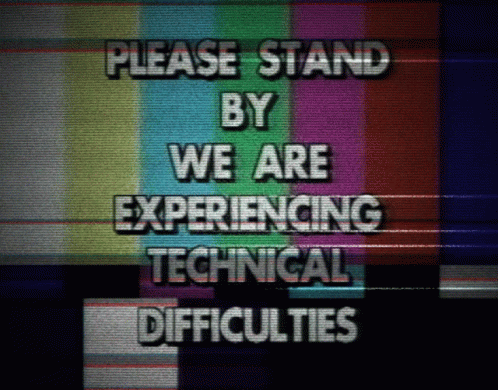Listen to the audio version of this post here:
How late was it when you realized that you were up way past your bedtime? Perhaps you were sneaking a look at late-night TV in your panelled basement rec room while your parents dozed upstairs.
Who knew what time it was? Who cared? Not you.
What you did know was that it was late - very late - when that rainbow-coloured pattern came on the TV screen.
The multicoloured, vertical lines of the now-extinct test pattern were common to those of us who grew up during a time when analogue communications ruled.
“We are experiencing technical difficulties. Please stand by!”
These words were also commonplace when, per chance, the analogue transmissions of the day failed and one's TV-watching plan was abruptly interrupted. Add to this inconvenience a high-pitched screech and you can imagine how annoying this situation could be. Annoying and oh, so very common at one time.
“What’s a test pattern?” you may ask.
Well, if you’re of a certain age, you will surely remember the days when there were technical issues at the broadcast source, and there was a finite end to TV programming for the day. Yes, believe it or not, entertainment, news and whatever else you liked to watch on the tube ended at a certain time every night. And yes - technical difficulties did occur, often.
If you’re of a certain age, you will surely remember the days when there was a finite end to TV programming for the day.
You have to understand: these were the days before cable news, 24-hour TV and online and digital access that allowed you to watch YouTube, TikTok and cat videos around the clock, to your heart’s content. Yes – during these days of antiquity, those of us who wanted to relax and watch TV knew that at some point, the fun and games would end. The national anthem would come on and then and only then, you’d see the dreaded test pattern. Game over.
During these days of antiquity, those of us who wanted to relax and watch TV knew that at some point, the fun and games would end. The national anthem would come on and then and only then, you’d see the dreaded test pattern. Game over.

The test pattern – also known as the test card - can be traced back to the early days of broadcast television. This programming standard was originally used to indicate that the TV transmitter was active, even though no programs were being broadcast. In the earliest of times, the test pattern was an actual physical card that was in the line of sight of the television camera, indicating various colours and and geometric lines in the aid of calibration, alignment and similar factors.
Original test patterns were in black and white because in the early days of television, colour transmission of TV shows was a futuristic fantasy. Created by RCA in 1939, the black and white test pattern was the standard for a number of years, before the more easily recognizable colour test pattern, the one with vertical, multi-coloured bars, took hold. The black and white images that were sent across the airwaves landed on the clunky, cathode-ray boxes that televisions used to be, signalling – literally – that invisible waves of promise were just hours away, OR had ended for the day.
This iteration of the test pattern was officially known as SMPTE colour bars, with SMPTE standing for The Society of Motion Picture and Television Engineers. It was this group that established the colour bars as the North American video standard in the early 1970s. This well-known pattern was often accompanied by a high-pitched tone, indicating to the viewer that a test was underway – or that programming was about to end for the evening.
But enough of this technical stuff. Let’s get back to the reason behind this piece, which is a lament for a time when the day - and night - ended, as per the appearance of the test pattern. All this talk of national anthems followed by high-pitched screeching, finished by the inevitable SMPT rainbow is making me verklempt. The warm and fuzzy feelings of being simultaneously disappointed that TV-watching was over for the night, along with the sheer exhaustion of being a kid, up way past her bedtime, is almost too much to bear.
This, because like with all technological advances, previous versions disappear, never to be seen again. Though once a common sight for those who were able to stay up long past the 11 o’clock news, the test pattern saw its demise as technology’s advancement changed the way that television viewers watched the tube. With the advent of a 24-hour news cycle precipitated by cable news channels and digital/social media, TV stations were under increasing pressures to NEVER go off the air. Content was now king, even if that content was questionable. So here we are in the 21st century with the ability to watch videos to our heart’s content, with no pause for reflection (or sleep). But is that really something that we always wanted? Perhaps it is for those digital natives who know no other way. For those of us who do, we miss the definitive end to the night’s programming that reminded us that we should turn off, tune out and go to bed.
N.B. I found this short clip on YouTube. Somehow, it’s strangely satisfying. Lots of memories, too:





